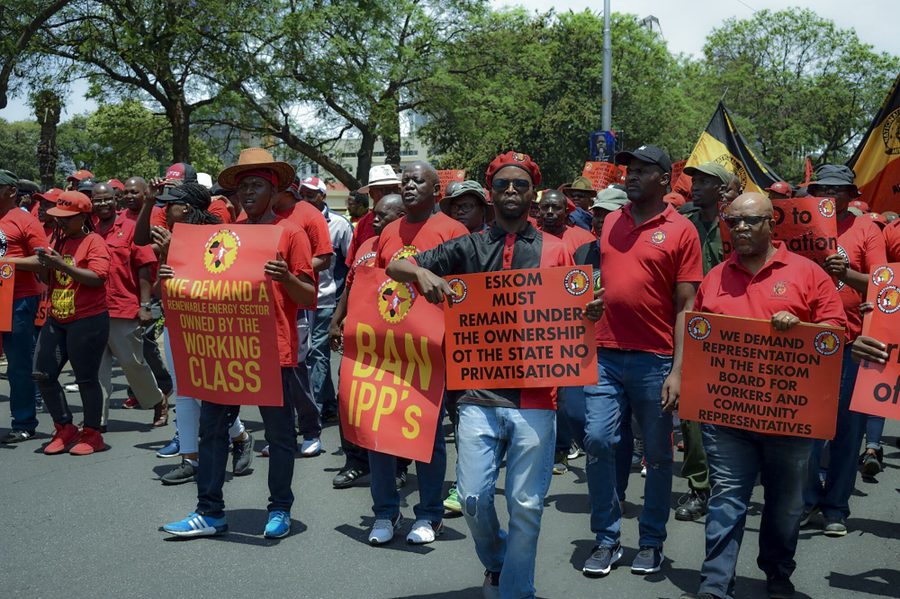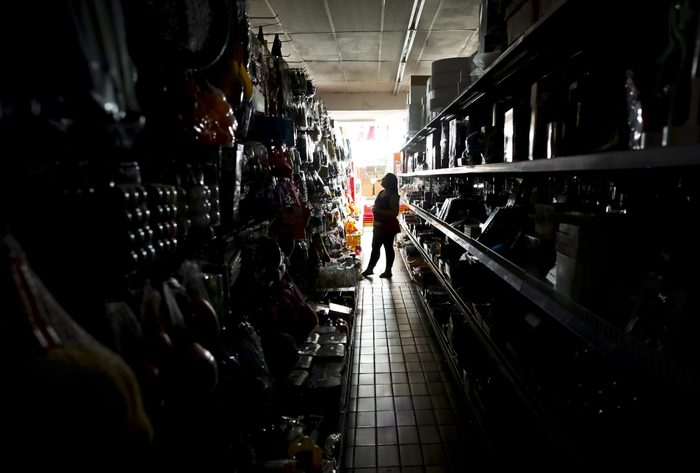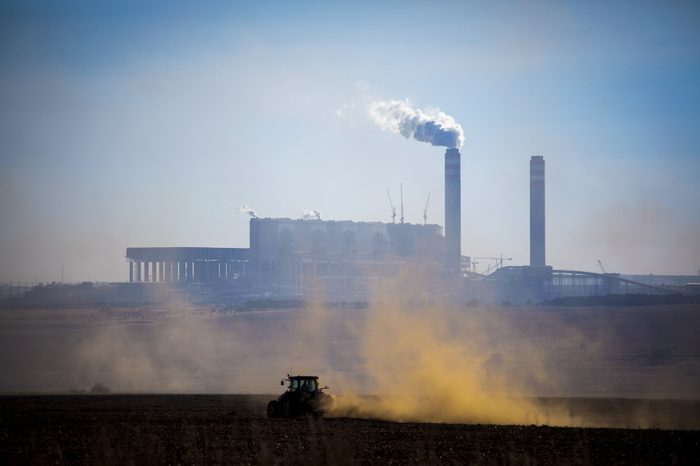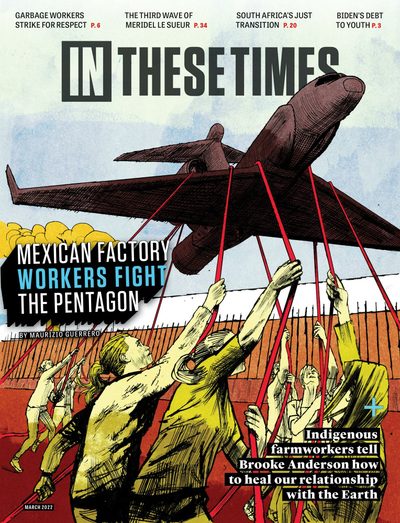Amid Rolling Blackouts, Energy Workers Fight For Clean Public Power In South Africa
Can South Africa transition from a reliance on coal to clean power while maintaining jobs? The energy workers fighting for a just transition think so.
Casey Williams

The lights went out around Johannesburg on a Monday morning in November 2021, not to flicker back on until early that Friday in some areas. It marked the last rolling blackout of a year troubled by more outages than any in recent memory. The fate of Eskom, the beleaguered power utility behind the crisis, is now at the center of South Africa’s struggle for a just energy transition — a break from fossil fuels without leaving behind frontline communities or energy workers.
As a public company, Eskom has a constitutional mandate to guarantee electricity as a basic right. But the utility struggles to meet that mandate with its aging equipment, staggering debt, corruption and rules that require it to break even, which drive exorbitant rate hikes. Moreover, the electricity running through Eskom’s wires comes almost entirely from coal, smothering the country’s eastern coal belt in deadly pollution and adding planet-warming emissions to the atmosphere — and putting the utility at odds with South Africa’s decarbonization commitments and global calls for renewable energy. South Africa, the 26th-largest country by population, ranks 14th in carbon output worldwide and is responsible for 1% of global emissions, because of this reliance on coal.
Few believe Eskom will survive in its current state, and what comes next is the subject of a high-stakes debate — and is about more than the climate. The state-owned company employs 45,000 workers and supports 82,000 coal jobs in a country where more than a third of the population is out of work. Eskom is a union shop, as are South Africa’s biggest coal mines.
The government’s plan, already underway, is to invite private companies into the energy sector on the dubious grounds that clean energy is bound to win in a competitive market. The powerful miners and metalworkers unions oppose privatization, which they worry will hobble their organizations, if not eliminate the jobs they’re entrusted to protect.
The unions have reason to worry. European multinationals have installed most of South Africa’s wind and solar capacity so far, importing technicians and hardware. The local jobs that come with them are often low-paid and temporary, vanishing once plants get up and running. Workers with permanent jobs, meanwhile, have struggled with for-profit energy companies over the right to strike.
While some union leaders and workers have responded to the threat of privatization by defending coal mines and the union jobs they offer, unions also say they support decarbonization efforts. There are currents within the labor movement organizing for a just transition to turn Eskom into a unionized, public and clean power utility, run by and for the South African people.
This tug-of-war holds lessons for workers everywhere: The South African labor movement has largely succeeded in making the public debate about ownership and power— about who owns energy resources and who decides how they’re used — rather than simply about renewables versus coal. Still, the temptation for labor to double down on coal jobs remains strong as the South African economy flags and unemployment spikes, emblematic of how hard it can be to fight for long-term goals if jobs are under threat.

PUBLIC VISIONS
For Jabulani Sokhela, a works coordinator in Eskom’s distribution division who is sometimes directed to cut power to working-class districts, a just transition would mean keeping the lights on for his comrades. “Electricity is a basic need,” says Sokhela, 41, an electrical engineer by training and a member of the National Union of Metalworkers of South Africa (NUMSA). He is from a mining town on the eastern edge of Gauteng Province.
NUMSA members started organizing for a just transition in 2011, as South Africa was gearing up to host the United Nations’ COP17 climate summit in Durban. The union’s energy research and development group held workshops on decarbonization with workers, bringing in scientists to discuss climate change.
While not every member appreciated the significance of climate change at the time, Dinga Sikwebu, a former NUMSA official who led the group, says “I know of no other union that … had some of the people in the country who wrote or were involved in or part of the Intergovernmental Panel on Climate Change, who came in and ran workshops on climate change.”
In 2012, NUMSA adopted a vision for socially owned, worker-controlled, decommodified clean power that is among the most ambitious anywhere. Even the most progressive U.S. proposals, like the Bernie Sanders-backed Clean Energy Worker Just Transition Act, only propose federal investment, not a fully nationalized and democratized power sector.
Rooted in the principles of South Africa’s 1955 Freedom Charter and the National Democratic Revolution, the platform calls for public utilities to harness the country’s abundant wind and solar resources to provide clean power as a public good to South Africa’s population, including the millions who currently lack affordable electricity. Governed in part by municipal assemblies, this democratized clean power sector would guarantee good jobs and build workers’ skills.
Thanks in part to proposals from NUMSA and allied unions, South Africa was the only country to commit to a just transition at the 2015 COP21 climate summit in Paris.
However, the South African government has yet to translate that commitment into a plan for replacing fossil fuel jobs. NUMSA and the National Union of Mineworkers (NUM) have organized high-profile actions for wage hikes and just transition guarantees in recent years, including a 2018 march opposing Eskom’s privatization that turned into three months of rolling strikes and bargaining. The strikes won significant raises, but, after picketing again and even briefly shutting down several power stations, won no assurances that Eskom would aggressively pursue renewable energy.
The next year, 2019, saw a noteworthy climate-labor alliance as the South African Federation of Trade Unions (SAFTU), to which NUMSA belongs, joined a small but unprecedented demonstration in Pretoria organized by the General Industries Workers Union of South Africa and the environmental group 350 Africa, calling for a just transition.
In December 2021, hundreds of NUM members and supporters marched on Eskom’s headquarters in Johannesburg to oppose the utility’s privatization.
In addition to labor, organizers with the Alternative Information and Development Centre, a South African social advocacy group, have championed NUMSA’s vision of socially owned renewable power within the climate justice movement. According to Sikwebu, however, the enthusiasm for renewables among workers has begun to wane since 2012, in part because foreign renewables companies hired local workers only for temporary construction jobs.

PRIVATE POWERS
The privatization of South African power has been slowly increasing since 2011, when the ruling party, the African National Congress (ANC), opened a small crack in Eskom’s power monopoly. Through the Renewable Energy Independent Power Producer Procurement Programme, private renewable energy companies were allowed to sell power to the grid for a fixed term at a fixed price. Amazon has since built a solar plant to power a Cape Town data center, and a Turkish company won a lucrative contract (in an allegedly fixed bidding process) to provide electricity using floating natural gas plants known as “powerships.”
The government now hopes to widen that crack through something called “unbundling,” which would separate Eskom’s three operations — electricity generation, transmission and distribution — so private companies could more easily sell energy on Eskom’s wires. Because it would also require Eskom to buy these companies’ electricity at above-market rates, unbundling would, effectively, subsidize Eskom’s for-profit competitors in the name of decarbonization.
Foreign capital is backing the unbundling plan. One condition of the financing deal for clean energy that South Africa struck in 2021 at COP26 — $8.5 billion in grants and loans from the United States and several European countries — is that Eskom helps accommodate for-profit clean power producers.
Unbundling also has support on parts of the Left, as many environmental justice groups see it as the only way to put more solar and wind on the grid, according to Bruce Baigrie, former climate justice liaison at the Alternative Information and Development Centre. And while the Congress of South African Trade Unions, the country’s largest trade union federation (aligned with the ANC), does not explicitly support unbundling, “They’re also not necessarily coming out against it,” Baigrie says. That leaves the miners and metalworkers unions, and their handful of outside supporters, mostly on their own.
NUMSA, which split from the Congress of South African Trade Unions in 2014, has long opposed unbundling on the grounds that a public power monopoly is the best way to expand renewables while protecting jobs. Because of NUMSA’s opposition to unbundling, groups like Greenpeace Africa have accused the union of defending coal while South Africans suffer blackouts, pollution and climate change-related droughts and floods.
As the drumbeat for privatization intensifies, some NUMSA leaders are defending the coal industry. NUMSA General Secretary Irvin Jim has publicly supported calls by the pro-coal energy minister to resist global calls for a rapid shift away from fossil fuels, putting Jim at odds with many rank-and-file workers as well as the union’s official position.
Other NUMSA members worry leaders have been “captured by coal interests,” as one NUMSA staffer tells In These Times (on the condition of anonymity, fearing reprisal). Insiders told the Mail & Guardian in 2018 that the union’s financial woes had made Jim less accountable to workers than to the interests of NUMSA’s investment arm, headed by anti-renewable businessman Khandani Msibi. (Jim dismissed the accusations.)
Whatever their motivations, the rhetoric from NUMSA leaders portrays a new common sense regarding South Africa’s energy future — that South Africans must choose between private (but renewable) energy or public (but dirty) power.
Others say it’s a false choice. “The whole world is on the brink of moving from coal to renewable energy,” Sokhela says. But “workers on the ground see [unbundling] as another opportunity for … corrupt criminals we elect into parliament to further exploit the coffers of the country,” while handing the power sector over to for-profit companies.
As NUMSA’s former Deputy General Secretary Karl Cloete wrote in 2018: “We are against a capitalist transition organized around profit and exploitation. We are for a just and democratic transition.”
GETTING SOCIAL
Sikwebu contends that, even with privatization looming, achieving clean public power does not have to mean defending the Eskom status quo. He says the idea that clean energy can only come at the expense of public institutions rests on the mistaken view that public entities are unwilling to invest in renewables. Although Eskom was initially barred from entering the renewable energy market in 2011, the utility has since invested in solar and battery storage projects. City governments are also starting to procure or generate their own clean power.
“That, for me, is socially owned,” Sikwebu says.
Genuine social ownership of South Africa’s power remains out of reach, however, as long as investors like the World Bank own Eskom’s debt, since the loan agreements make the utility answerable to creditors rather than the public. The World Bank’s 2010 loan to Eskom allocated $3 billion for the construction of a coal plant while directing just $260 million to wind and solar projects.
The Alternative Information and Development Centre has developed a proposal to address Eskom’s debt, with input from NUM and NUMSA members. It calls on rich countries to provide “no-strings-attached investment capital for the energy transition.” It also proposes using South Africa’s public employee pension fund, which consistently runs a surplus, to bail out Eskom.
Beyond the debt problem, the economic climate has put labor on the back foot. Even before Covid-19 pushed millions out of work, unemployment in South Africa hovered near 30 percent. In 2018, it was reported that the largest trade union federation declined by over 40,000 members in two years as unions struggle to organize a precarious workforce.
Meanwhile, austerity measures adopted by the ANC to appease creditors have worsened already high levels of poverty and inequality, which have in turn sparked South Africa’s largest protests in decades. The immediate need to protect jobs, wages and public services against austerity has left South Africa’s increasingly fractured labor movement little space to organize for a pro-worker transformation of the energy sector.
But the struggle for clean public power is still alive within the labor movement. “Different views are finding expression in the union,” one NUMSA staffer says, but Sikwebu believes much more organizing is needed, within NUMSA and beyond.
Joining forces with unions representing different sectors will also be key to realizing the union’s vision for a just transition, according to Sokhela: “When we are divided, our power is also divided.”
Casey Williams is a researcher and freelance writer based in New Orleans. He writes about climate, energy and labor politics around the world. Williams has published work in The New York Times, The Nation, HuffPost, and other local and national outlets.








